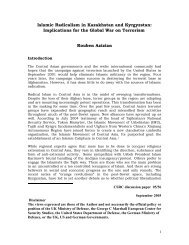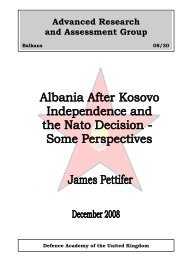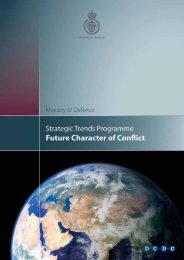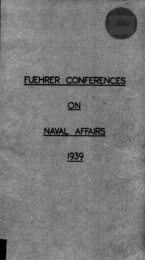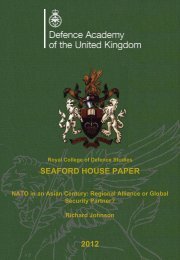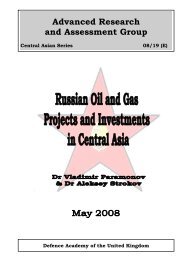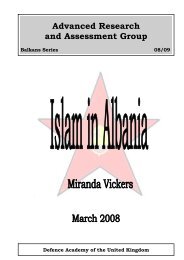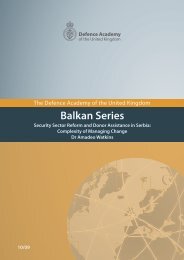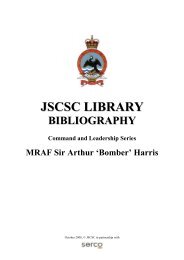The Russian Federation Navy: An Assessment of its Strategic ...
The Russian Federation Navy: An Assessment of its Strategic ...
The Russian Federation Navy: An Assessment of its Strategic ...
Create successful ePaper yourself
Turn your PDF publications into a flip-book with our unique Google optimized e-Paper software.
<strong>The</strong> principal national interests which he defined as those to be defended by the <strong>Navy</strong> were:Ensuring that the <strong>Russian</strong> <strong>Federation</strong> has an assured access to resourcesand expanses <strong>of</strong> the World Ocean, and excluding discriminatory actions inregard to <strong>its</strong>elf or <strong>its</strong> allies on the part <strong>of</strong> separate states or military-politicalblocs;Interdicting domination <strong>of</strong> any states or military-political blocs in theexpanses <strong>of</strong> the World Ocean that are <strong>of</strong> importance for the realization <strong>of</strong> the<strong>Russian</strong> <strong>Federation</strong>'s national interests, particularly in the contiguous seas. 92<strong>The</strong> principal military threat emanating from the ‘sea and oceanic sectors’ was defined as:‘an increase in the combat capabilities <strong>of</strong> ... the leading foreign states, including thecapability to engage targets in the entire territory <strong>of</strong> the <strong>Russian</strong> <strong>Federation</strong> [and] ...deployment on naval carriers <strong>of</strong> ... precision air weapons’. 93 That is, the primary definedthreat to Russia in the maritime environment is Western, specifically US and NATO. This isreflective <strong>of</strong> wider <strong>Russian</strong> military thinking, including within the new Military Doctrine, whichdefines the principal external military danger to Russia as:<strong>The</strong> desire to endow the force potential <strong>of</strong> the North Atlantic Treaty Organization(NATO) with global functions carried out in violation <strong>of</strong> the norms <strong>of</strong> internationallaw and to move the military infrastructure <strong>of</strong> NATO member countries closer tothe borders <strong>of</strong> the <strong>Russian</strong> <strong>Federation</strong>, including by expanding the bloc... 94<strong>The</strong> identification <strong>of</strong> the US and NATO as the principal military threats to Russia prioritiseshigh-intensity war-fighting as the main focus for the <strong>Russian</strong> Armed Forces. In the navalcontext, the basis for formulating military development and acquisition policy through to 2020is focused on enhancing the striking power <strong>of</strong> the fleet and <strong>its</strong> ability to contribute tocontinental operations:<strong>The</strong> naval forces, in conjunction with other services <strong>of</strong> the armed forces, will beable to conduct operations not only in the ocean and sea zones, but also on thecontinental theaters [sic] <strong>of</strong> operations owing to considerably enhancedcapabilities <strong>of</strong> aircraft-carrier forces, equipping surface combatants andsubmarines with cruise missiles. 95<strong>The</strong> <strong>Russian</strong> <strong>Navy</strong> is also intended to form a component <strong>of</strong> an integrated aerospace defencesystem for the <strong>Russian</strong> <strong>Federation</strong>. <strong>The</strong> Commander-in-Chief <strong>of</strong> the <strong>Russian</strong> <strong>Navy</strong>, AdmiralVladimir Vysotsky has stated, with regard to the development <strong>of</strong> plans concerning a newaircraft carrier capability, that ‘Russia’s aircraft carrier fleet should be an element in a singlemissile, air and space defence umbrella and should organically fit into <strong>its</strong> structure’. 96 Thisderives from the <strong>Navy</strong>’s focus on the destruction <strong>of</strong> opposing naval task groups as a coreoperational-strategic task. Admiral Masorin defined this as the primary role <strong>of</strong> the <strong>Navy</strong> afterthat <strong>of</strong> contributing to strategic deterrence:It will engage with fires the adversary's naval task forces in the far and nearmaritime zone, it will aid other Armed Forces services operating in sectors withan outlet to the sea ... <strong>The</strong> forms <strong>of</strong> the <strong>Navy</strong>'s employment will be as follows:91 Masorin, ‘Naval Doctrine as a Component Part <strong>of</strong> the <strong>Russian</strong> <strong>Federation</strong> Military Doctrine’.92 Ibid.93 Ibid.94 <strong>The</strong> Military Doctrine <strong>of</strong> the <strong>Russian</strong> <strong>Federation</strong> (2010), p. 3.95 Major-General Nikolai Vaganov [Deputy Chief <strong>of</strong> the <strong>Russian</strong> Armed Forces’ Main Armament Research andDevelopment Department], ‘Armaments and Military Equipment Development Through 2020’, Military Parade,Issue 4, July/August 2009, pp. 4-6.96 ‘Russia to design own aircraft carrier by end <strong>of</strong> 2010 – navy chief’, RIA Novosti (via LexisNexis), 26 February2010.14



